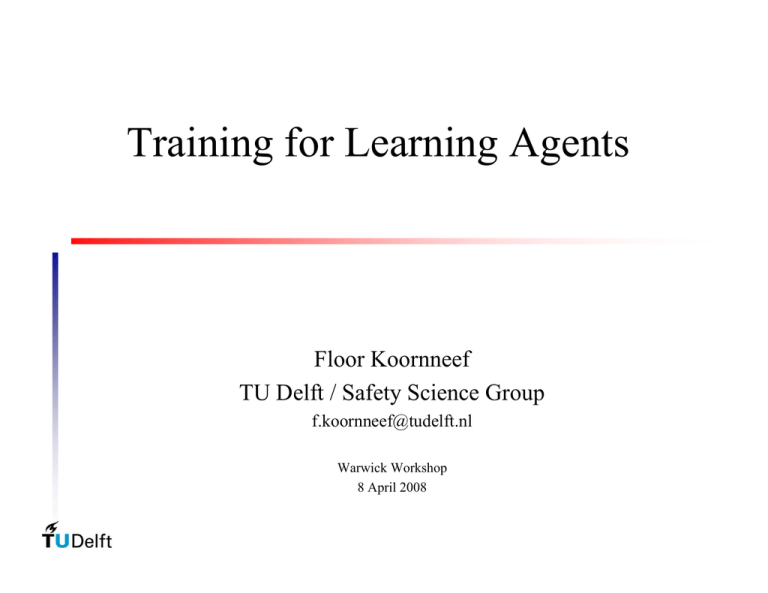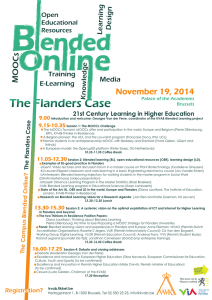Training for Learning Agents Floor Koornneef TU Delft / Safety Science Group
advertisement

Training for Learning Agents
Floor Koornneef
TU Delft / Safety Science Group
f.koornneef@tudelft.nl
Warwick Workshop
8 April 2008
Introduction
ongoing
work in LUMC on Organisational
Learning from critical patient safety
experiences
–
Pilot 1: neonatology (2006); Pilot 2: children
and youth care centre (2007-’08)
Setting
–
up OL processes {| OL principles}
Organisational Learning needs to be organised!
Preparing
–
–
Learning
Learning Agency
Learning Agents
2
Basic components in processes of
Organisational Learning: SOL-model
relevant
management
learning agency
work process
learning agent
OL memory
compensation of
loss of context
…needs to be organised
3
organisation
match
organisational unit
Learning Levels
Governing Variables (values,
norms, means)
adjust
people & means
make product
(work process)
surprise:
mismatch !
detect
adjust
individual single-loop learning
notify
OL system
organisational single-loop learning
Individual
–
(single loop)
individual change of theory-in-use
Organisational
–
–
organisational double-loop learning
Single loop
within span of control of unit management
Organisational
–
Agency
inquire
Double loop
beyond span of control of unit management
unit-governing variables => unit must adapt
Deuterolearning
4
Questions leading to Lessons
Do the
people
match the
plant and
hardware?
Plant and
hardware
People
Do these
procedures
match the
people who
use them?
Procedures and
Management
Do the
Controls
procedures
match the
plant and
hardware?
What
–
are the structural factors in incident
people / apparature / procedures / context
Which
of these can be influenced or resolved
by unit management …
–
–
with little/much effort
in earlier phase of patient throughput in BPM
Select
factors & formulate recommendations
as lessons-to-implement for unit management
5
Training of Learning Agents
of Learning Agencies in OL context
Contents
–
–
WHAT is there TO LEARN? Patient Safety: OR!
Methods for incident reconstruction:
•
•
–
ECFA+: events and conditional factors analysis
3CA (going into root cause analysis)
Handling of loss of context (notification & lessons)
Levels
–
–
of training
of Training:
Learning Agents: skills to apply ECFA+, grasp of
3CA, understanding of OR
Learning Agency: basic grasp of OR + methods
6
Holistic view on patient care:
MEI-flows model
humanware
hardware
software
ENVIRONMENT
OR / 1
Patient-threatening hazards related
to medical devices/systems
application
•
•
•
•
user errors
calibration
inadequate maintenance
system configuration
Information errors
installation
disturbances (origin)
•
•
•
•
•
•
•
electrical
mechanical
chemical
biological
radiation
environmental
explosion
direct influences
devices
indirect
influences
• coupling with other
devices
• Electro-Magnetic
fields interference
• disruption of
power supply
• earthing
• environment
• ventilation
patient,
user
OR / 2
Operational Readiness
Nertney's Wheel (simplified)
Do the
people
match the
plant and
hardware?
Plant and
hardware
People
Do these
procedures
match the
people who
use them?
Procedures and
Management
Do the
Controls
procedures
match the
plant and
hardware?
...or WHAT is there TO LEARN?!
OR / 3
Upstream Processen
OR / 4
Assuring Operational Readiness
OR / 5
Training of Learning Agents
of Learning Agencies in OL context
Contents
–
–
WHAT is there TO LEARN? Patient Safety: OR!
Methods for incident reconstruction:
•
•
–
ECFA+: events and conditional factors analysis
3CA (going into root cause analysis)
Handling of loss of context (notification & lessons)
Levels
–
–
of training
of Training:
Learning Agents: skills to apply ECFA+, grasp of
3CA, understanding of OR
Learning Agency: basic grasp of OR + methods
6
www.nri.eu.com
ECFA+ artwork
Evidence
S14
D. Albers
Time
1520
9.8.00
EVENT
Use present tense, one actor/action/object
Comments
Turns valve until
tight
E32
Format Check
Time
Time
S14
D. Albers
1520
9.8.00
Analyst
JK
Logic Check QUERY
Why did
Albers close
the valve until
tight?
CONDITION
CONDITION
Albers closes valve “A”
ECFA
Ref.
Evidence
Evidence
Valve “A” is
overtighted
Analyst’s basis of judgement
Analyst’s basis of judgement
SOP 16 requires 8 turns
(number of turns to be
counted)
ECFA
Ref. C38
Analyst
Format Check
Format Check
JK
Logic Check
Logic Check
What? Why? Where? How? When? Who?
Query posted at
(time & date)
10:40, 9/8/00
Added to l ist of
further enquiries
Analyst
JK
ECFA+ example
From ECFA+ to 3CA
3CA form
Training of Learning Agents
of Learning Agencies in OL context
Contents
–
–
WHAT is there TO LEARN? Patient Safety: OR!
Methods for incident reconstruction:
•
•
–
ECFA+: events and conditional factors analysis
3CA (going into root cause analysis)
Handling of loss of context (notification & lessons)
Levels
–
–
of training
of Training:
Learning Agents: skills to apply ECFA+, grasp of
3CA, understanding of OR
Learning Agency: basic grasp of OR + methods
6
Keyhole Problem
What are you looking at?
Context handling: business process model
Compensation of Loss-of-Context
in
–
–
by
–
–
notification data model:
use Business Process Model in notification
use known risk scenarios (e.g. {S3 | condition Y})
learning agency:
members from operational level (sharing 'mental movies')
context reconstruction by inquiry
Training of Learning Agents
of Learning Agencies in OL context
Contents
–
–
WHAT is there TO LEARN? Patient Safety: OR!
Methods for incident reconstruction:
•
•
–
ECFA+: events and conditional factors analysis
3CA (going into root cause analysis)
Handling of loss of context (notification & lessons)
Levels
–
–
of training
of Training:
Learning Agents: skills to apply ECFA+, grasp of
3CA, understanding of OR
Learning Agency: basic grasp of OR + methods
6
An example: leakage in HFO-unit
Patient was admitted into the IC
neonatology and received HFO-respiration support in the late shift. The night
shift noticed at 6:30 h. that the valve of
the water trap of the disposable was
missing. No alarm had gone off. Around
9:00 h. the leakage was stopped and the
proper device settings were restored.
The patient did not suffer any harm.
Testing showed that loose valve drops
out within 15'.
Lessons
1.
2.
3.
Yellow sticker at the disposable : tighten the valve!
Insert in protocol : check all connections of the whole HFOsystem
Prepare this case as courseware for HFO- en NO-training.
Point out in clinical training of nurses that deviating settings
indicate leakage
Spread the lessons within LUMC and - if needed nationwide
Do the
people
match the
plant and
hardware?
Plant and
hardware
4.
People
Do these
procedures
match the
people who
use them?
Procedures and
Management
Controls
Do the
procedures
match the
plant and
hardware?
Outcomes of Case Review
Insight
in nature of operational problems of
quality assurance
Identification of external factors
Workable lessons ('by nature')
Evidence-based dossier
–
–
–
–
Notification form (low threshold)
ECFA+ reconstruction
Test report (when applicable)
PowerPoint report including the lessons to be
implemented
8
PVN Case xx
Cardioloog B komt een hartecho maken op neonatologie van
patiënt A met het echoapparaat van de cardiologie, omdat
deze betere hartbeelden oplevert. Dit toestel heeft een
“normale” randaarde stekker, geen verloopstekker voor het
verzwaarde 220V-net. Er is wel een verloopstekker geweest
maar die is kwijt. De cardioloog sluit het apparaat aan op het
"groene" stopcontact en schakelt het in, waarop die groep
uitvalt en de hierop aangesloten apparatuur eveneens. De
patiënt ligt aan beademing en heeft diverse infuuspompen die
onmiddellijk worden overgezet op een andere groep. De HFO
viel terug op batterijvoeding. De technische dienst is gekomen
om de stroomvoorziening te herstellen. De echo is alsnog
gemaakt met het apparaat van de neonatologie.
1
PVN Case xx - ecfa+
xx
4
Vragen voor nader onderzoek
#
Info nodig…
Q1 Zit er een noodstrooomvoorziening aan aan
Bron Ref
FK
E05
FK
C09
FK
C04 >
C05 >
C06 >
E02
FK
E10
CV
Q3
Prio
PVNxx
"groene" groepen? Zo ja, Waarom viel de
apparatuur uit?
Q2 Heeft de "groene" groep bijzondere schade
opgelopen?
Q3 waarom wordt er gewerkt met
verloopkabels?
Q4 is de kwaliteit van de hartecho m.b.v.
apparaat van Neonatologie toch goed
genoeg?
Q5 op IC-neuro vliegen bijna wekelijks op deze
wijze de stoppen eruit... Waarom? [bron: TD]
Do the
people
match the
plant and
hardware?
Plant and
hardware
People
Do these
procedures
match the
people who
use them?
Procedures and
Management
Controls
Do the
procedures
match the
plant and
hardware?
Vragen voor nader onderzoek
#
Info nodig…:
Q1 Zit er een noodstroomvoorziening aan
"groene" groepen? Zo ja, Waarom viel de
apparatuur uit?
Review – lessen PVN Case xx
Bevindingen
Ja, binnen 15' komt
spanning terug na
externe stroomuitval.
N.v.t. Zekering viel uit!
Opties:
Q2 Heeft de "groene" groep bijzondere schade Nee. Als zekering weer
opgelopen?
Q3 waarom wordt er gewerkt met
verloopkabels?
Q4 is de kwaliteit van de hartecho m.b.v.
apparaat van Neonatologie toch goed
genoeg?
IN, dan alle apparatuur
opnieuw instellen
Apparaatgebruik onder
verschillende installatievoorzieningen
Ten dele smaakkwestie
plus apparaat Cardio is
nieuwer
Q5 op IC-neuro vliegen bijna wekelijks op deze Vraag wordt doorgeleid
wijze de stoppen eruit... Waarom? [bron:
5151: storingsdienst]
naar CMC
Do the
people
match the
plant and
hardware?
Plant and
hardware
People
Do these
procedures
match the
people who
use them?
Procedures and
Management
Do the
Controls
procedures
match the
plant and
hardware?
1) verloopsnoer leggen op apparaat van Cardiologie
2) actie naar Cardiologie: gebruik verloopsnoer op
Neon!
3) FW (hoofd Neon) vraagt bij hoofd FD waarom
apparaat niet met blauw snoer wordt geleverd
4) Vraag Q5 voorleggen aan CMC (Centrale Materialen
Commissie)
5) Plaats ook hoger belastbare witte stopcontacten op de
ICs
Keuze: 1 + 2 + 3 + 4 + 5
8
Principles in Patient Safety OL Pilot
project
–
is owned by each unit+LUMC
TU Delft supports (methodologically)
mobilise
–
expertise members Learning Agency
Support by own learning agents is crucial
builds
much as possible on current practice
'evidence-based' case-review in order to learn
regarding assurance of own work processes
"Organisational Learning" by units within LUMC
¾
a lesson is learned only by implementing it!
9
Biomedical Engineering courses
(as part of BME minor)
Lecture (2 hours) in Medical Technology course
includes brief intro in standards and regulation
Practical (2 ECTS)
Failure Mode and Effect Analysis
Fault Tree Analysis
Quality Assurance Metrics [T. Gilbs]
trained at skill level…
applied to medical system
10
Clinical Physicists
(post-graduate) module
5 thematic afternoons + exam thesis, incl.
General Framework for RA and RM
Risk Analysis methods, incl. FTA, FMEA
Organisational Learning from Incidents
Work processes and design of MeD
Regulation and standardisation - user
perspectives; safety case approach
11
